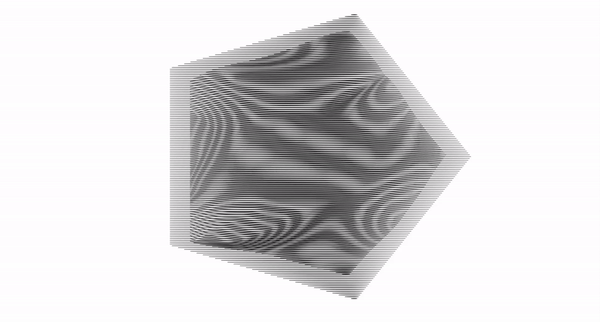This interview was originally published on O Sitio on May 4th, 2020.
O Sitio: Tell us about your Interference Patterns series?

I have always been intrigued by the moiré optical effect. It is so simple and yet so complex. As if there were a second level of design, subtle and unintentional, in addition to each line. This new series is an exploration of interference patterns and unexpected vibrations that different algorithms can create in what is essentially a series of horizontal lines. Each work of art uses a different source of noise to influence the topology of the patterns (fibrous, dented, turbulent ...) and the resulting moiré is generated as a loop sequence in a few hundred frames. This provides enough variations for me to choose some of my favorite frames to plot. In this artwork, I was interested in plotting on thin Japanese Sumi-e paper that is very sensitive to ink. A few milliseconds of contact with the pen and ink begins to merge through the fibers which I feel adds more vibration to each drawing. I always reorder my line work from one side of the page to the other for the plot video to look more organic. I like to see which line the plotter will draw next, and sometimes there is a little ghost in the shell. I decided to create the series on simple sequential polygonal shapes to introduce a gradual increase in complexification as noise patterns evolve. I think you can never control Moiré which is a good summary of the philosophy behind my work at the moment. Don't try to control everything, it's a chance to make lucky accidents happen.

O Sitio: Who are you?
I’m an Innovation Design Engineer based in London. I trained initially as a Mechanical Engineer and I’ve always been making things. I like to get involved with different types of technologies. I’ve been building my own drones and 3d printers and all sorts of little electromechanical projects for a while. After graduating from the Royal College of Art in 2014, I started getting interested in pen plotters and how they can be a good tool for playing between the physical and the digital world. I think that was my entry point into the generative art world. I’ve been focusing a lot of my time since then trying to develop interesting themes that really push the boundaries of the tools - the physical ones like the pen and the inks as well as the paper and the digital ones between 3d packages, coding, node programming etc.
O Sitio: What is your creative process?
My process usually starts in the digital world. I’ll work with a few programs like Cinema4D or Grasshopper where I’ll start to put together some elements together to create a specific effect that I’m interested in. I build it as a recipe and in generative art you can re-render or re-create hundreds of variations of the same recipe. It’s all about finding the parameters that are going to have some dramatic impact on the overall result.
Then usually I take a few frames that I find particularly interesting and I jump into the plotting side where I’ll choose a combination of paper and ink that I think is going to create an interesting result. I use an Axidraw A3/V3. I usually end up plotting many times the same drawing until I have something that feels right. It’s really unexpected the reaction of the pen and the ink, the paper, the velocity of the drawing. There’s only one way to test it out and it’s by drawing multiple iterations. Every time, there is an element of surprise and serendipity in the result and that’s what I find interesting: you’re not in control of all the elements. You let some of those little accidents go their way, and sometimes that’s the most interesting part of a specific drawing.
O Sitio: How have you been dealing with the pandemic?
The current crisis we’re in is an opportunity to take a step back, think of what the best way to spend your time is, and certainly taking a bit of perspective on the things that are the most valuable to you. Personally, it’s been also the opportunity to take some time to learn new skills. Learning is one of those things that are so easy to push away, but now is a good time to get through that learning curve. One of the great things about digital art is that you don’t need much space. All you really need is a computer. It’s been exciting to see a lot of new generative artists joining the movement and I think the community is going to be growing rapidly. It’s inspiring to see more people spending time on their artworks and sharing through social media.

Pierre Paslier works with startups in London during the day and is a generative artist at night. He graduated from the Royal College of Art in 2014. A heartfelt creator, he has been obsessed with drawing robots for the past two years. He is based in London and is an active member of the vibrant generative local community. His work is mainly plotter based, experiencing the intersection between the physical and the digital. He founded Generative Hut in 2019 as an anchor for the generative artistic community. He's always buying too many pens.
Pierre Paslier, London, UK
